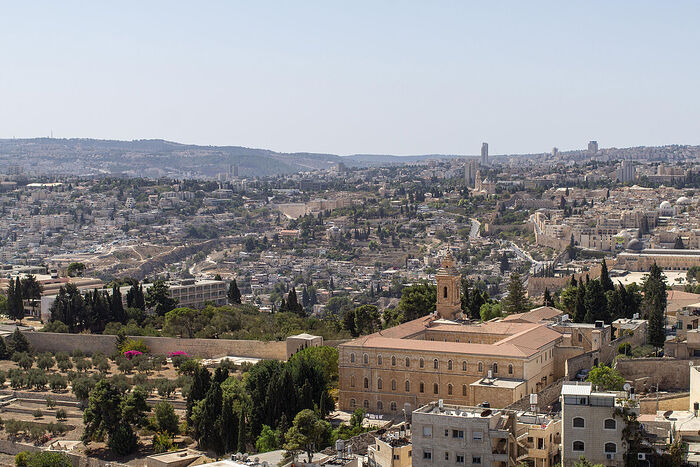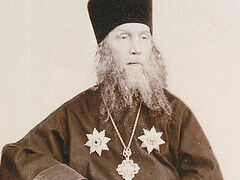Along the eastern wall of ancient Jerusalem stretches a mountain ridge called the Mount of Olives.
It was first mentioned 1100 years before the Birth of Christ in the Bible, in the Second Book of Kings, which describes the expulsion of King David from Jerusalem and his withdrawal to the Mount of Olives for prayer.
About 2000 years ago, many events described in the Bible took place at this site. At the foot of the mountain is the Garden of Gethsemane, where Jesus gathered his disciples. And at its top is the place from where Christ ascended to Heaven; and as predicted, He must return here.
A large plot of land next to the Chapel of the Ascension on the Mount of Olives was obtained by the Russian Orthodox Ecclesiastical Mission in Jerusalem in the person of its head, Archimandrite Antonin (Kapustin; 1817–1894), in the second half of the nineteenth century.
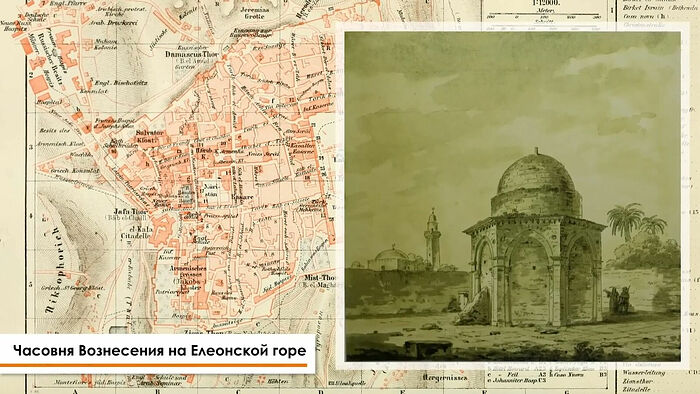 The Chapel of the Ascension on the Mount of Olives
The Chapel of the Ascension on the Mount of Olives
This allowed the construction of a church in honor of the Ascension of the Lord, a 210-foot bell-tower, and hostels for pilgrims who flocked to the Holy Land from all over the Russian Empire.
The Russian Church of the Ascension’s magnificent bell-tower, the so-called “Russian Candle”, dominates all the environs of Jerusalem. From its upper tier you can see the Dead Sea and Transjordan, and with the help of binoculars on a clear day—even the blue of the Mediterranean Sea. The powerful ringing of its bells resounds throughout the Mount of Olives and Jerusalem.
In 1906, a monastic community for nuns, initially consisting of fifteen sisters, was founded at the Church of the Ascension of the Lord. By the end of 1907 the number of sisters had increased to 100. This is how the Russian Ascension Convent on the Mount of Olives came into being.
We have talked with Novice Nun Manetha (Sizintseva).
—Sister Manetha, you struggle at the Russian Convent of the Ascension of the Lord on the Mount of Olives. Please tell us about this amazing place.
—The Mount of Olives is one of the holiest places on earth, including in the Holy Land. This is where the Ascension of the Savior, our Lord Jesus Christ, took place. A lot of events of the Old Testament, but mostly of the New Testament, are connected with the Mount of Olives. Here the Lord prayed and predicted the last days of Jerusalem. He descended from this mountain when entering Jerusalem. At the foot of the Mount of Olives He prayed in the Garden of Gethsemane before His Passion. Here He often met with His disciples. The Gospel says that when the Lord came to Jerusalem, He would spend days teaching in the Temple and spend nights on the Mount of Olives in prayer. Here, according to tradition, the prayer “Our Father” was given to mankind (of course, not on the territory of our convent, but elsewhere on the Mount of Olives). And most importantly, it was from here that the Savior’s Ascension to Heaven took place. This is one of the main pilgrimage destinations of pilgrims coming to the Holy Land.
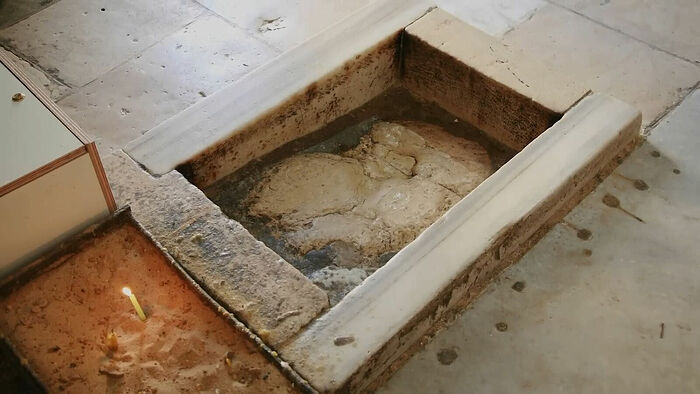 The site of Christ’s Ascension to Heaven
The site of Christ’s Ascension to Heaven
They make their pilgrimage tour and conclude it at the site of Christ’s Ascension to Heaven. After His resurrection, the Lord appeared on the Mount of Olives several times, and His last appearance was when He ascended to Heaven.
We have a rock in our convent, which, according to tradition, was taken from the very site of the Ascension of the Savior. It is located a little further from our convent. It has belonged to Muslims for several centuries. Since Muslims venerate Jesus Christ as a prophet, they refuse to give Christians the ownership of this place.
—When choosing the site of the convent, was there an intention to purchase land as close as possible to the site of the Lord’s Ascension?
—The fact is that it was not originally a convent. In 1865, Archimandrite Antonin (Kapustin) became the head of the Russian Orthodox Ecclesiastical Mission in Jerusalem. Having extensive experience in pastoring Russian pilgrims in Athens, at the embassy church, and then in Istanbul, he became the head of the Russian Ecclesiastical Mission here in Jerusalem and set about purchasing plots on the Mount of Olives. It was very difficult for Russian pilgrims in those days. About 10,000 pilgrims from the Russian Empire traveled to pray in Jerusalem during the year. Their journey would be very complicated. The task of the Russian Ecclesiastical Mission was to help them in the Holy Land with infrastructure, accommodation, food, etc. At the same time, Father Antonin wanted churches to appear where people could pray in their native language and where services would be celebrated in Church Slavonic.
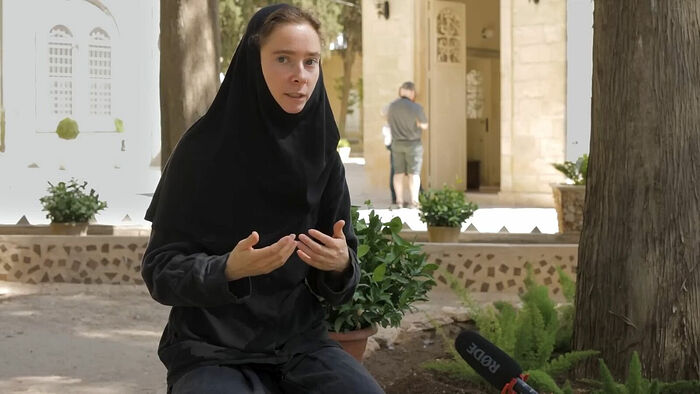 Novice Nun Manetha (Sizintseva)
Novice Nun Manetha (Sizintseva)
When he began to obtain plots on the Mount of Olives, the first thing Father Antonin did was to excavate and clear this place. Then ancient slabs of the Byzantine era, dated around 614 A.D., were found. There had been Greek Orthodox churches here, destroyed during the invasion of the Holy Land by the Sassanian King Khosroe. These slabs prompted Father Antonin to build an Orthodox church here again. Initially, he had wanted to build a hospice for pilgrims here on the Mount of Olives, as this was one of the goals of the Russian Ecclesiastical Mission. But when the slabs of the ancient church were discovered, Father Antonin said that an Orthodox church should appear on this site again.
And the construction of an Orthodox church commenced. The columns of an ancient Byzantine-era church and some slabs with incomprehensible marks, as if stains of blood, were discovered.
Father Antonin wrote in his diary that these seemed to be stains of blood of the martyrs killed during the invasion by King Khosroe in 614 A.D. During the construction of the church these slabs were returned to the very spots where they had been discovered. These slabs are located asymmetrically. They lie in the sites where they were found.
But it took a very long time to build the church. Initially, there were no plans to found a convent—there was only a plan to build a church. In the 1870s, Father Antonin bought this land on the Mount of Olives, on which the Russian Ascension Convent is now located, and in 1873 the foundation stone of the church was laid. And it was only in 1886, almost fifteen years later, that the Patriarch of Jerusalem consecrated this church.
Our church was built with funds donated by pilgrims from all over the Russian Empire, both rich and poor. Therefore, it was built slowly, and the construction of the church took almost fifteen years. There were also problems with the local population.
—What kind of problems?
—The environment was not Orthodox, but Muslim. They put various obstacles in our way. They weren’t interested in having an Orthodox Christian church here.
The church was built of white stone. This is Jerusalem’s stone, limestone. The whole of Jerusalem was built of it—Jerusalem is white. Father Antonin decided to build a church of this stone. A little later, in 1884, the bell-tower, the so-called “Candle of the Mount of Olives”, was built. It was consecrated simultaneously with the church. This bell-tower stands on the highest point of the Mount of Olives. Since the Mount of Olives is part of Jerusalem, it is actually the highest point of Jerusalem.
—What are the current tasks of the Russian Ecclesiastical Mission?
—The same tasks remain—to support Orthodoxy in the Holy Land, to help both Greeks and Russians. They used to help with education also—schools were built. Initially, the Palestine Committee was set up, which later transformed into the Imperial Orthodox Palestine Society. It was headed by Grand Duke Sergei Alexandrovich, the husband of Grand Duchess Elizabeth Feodorovna the New Martyr. The purpose of this society was to support Orthodoxy and the entire Russian population, all Orthodox pilgrims coming to pray at Holy sites. Over 100 schools were established where the Russian language was taught. Many Arabs spoke Russian at that time. For example, Yakub Halebi, a famous dragoman and translator of Father Antonin’s works, spoke Russian perfectly. Since he was a subject of the Turkish Empire, and the Holy Land was then under the Turks, he had the right to obtain plots in the Holy Land. Foreigners had no right to obtain plots of land, according to the law. Being a faithful member of the Orthodox Church, Yakub Halebi obtained plots in his own name and then bequeathed them to Fr. Antonin and the Russian Ecclesiastical Mission as donations. Thus, under Father Antonin at least thirteen plots were obtained, which we now have in the Holy Land. These are the Gorny Convent, the Mount of Olives Convent, Hebron, the Oak of Mamre, sites in Jericho, and many others.
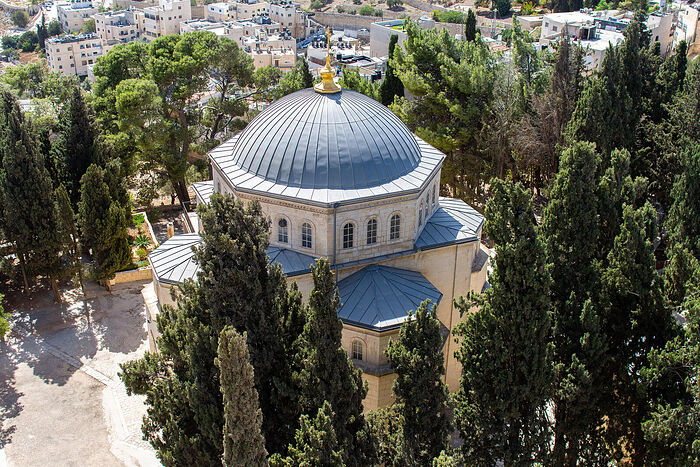 The Ascension Convent on the Mount of Olives
The Ascension Convent on the Mount of Olives
—When was a convent formed here?
—In 1906, after Archimandrite Antonin’s death, a community for nuns was founded on the Mount of Olives. The first abbess was Nun Evpraxia (Milovidova), who came from the Moscow St. Alexis Convent where she had been a novice. She knew Fr. Antonin. She became the abbess of the convent when Fr. Parthenius was abbot. In 1906, the first year of her abbacy, there were only fifteen sisters. These were the women who helped organize the entire church life. Since at first it was just a church, services were celebrated only on Sundays and Thursdays. But they arranged everything there: They donated, organized a choir and helped. The first community of fifteen nuns was formed from them.
Within a year, the number of nuns had exceeded 100. We are indebted to Mother Evpraxia for the fact that in 1914, when she died due to heart failure, over 100 sisters remained at the convent. Abbess Elizabeth was appointed the next mother-superior. The community was given the status of a convent. Now we have a smaller community.
 Mother Evpraxia —How many sisters do you have now?
Mother Evpraxia —How many sisters do you have now?
—About forty.
—From which countries?
—From different countries. We have sisters from Russia, Ukraine, America, France, Germany, and Romania. We have many sisters from Romania. One sister is from Estonia. There are also sisters from Palestine—they are Arab. But this is separate story; when I came to the convent there were seventeen Arab sisters, but there are fewer than ten of them now.
—What language do you communicate in?
—In Russian.
—How can women enter your convent?
—It is as in all monasteries. There is the same mechanism here: the fulfillment of the will of God. If it is God’s will for this, a woman comes, turns to the abbess, and the abbess blesses her to labor and live here for a while. If there is God’s will, the woman in question is ready for the monastic feat, then she remains and struggles here.
—Is the monastic life a real feat?
—Indeed, the monastic life is a feat, because it is a supernatural life. There is a natural life, marriage. There is also an unnatural one—various sins that are against human nature. And there is a supernatural one, which is considered to be angelic. When you imitate the angelic life, it is monasticism.
—You live in the Middle East. What are the specifics of performing obedience in the Holy Land?
—The specifics are that the most important shrines are located here. These are the Church of the Holy Sepulcher—the site of the Savior’s Resurrection; Golgotha—the place of His suffering; we are on the Mount of Olives—this is the site of His Ascension; the Garden of Gethsemane where He sweated blood before the Passion. It all leaves an inner imprint on people. And when someone comes here, he feels these events deeply and comes into contact with them. The memory of this place is continuously present here, and it is marked by the light of the Resurrection of Christ.
The event of the Resurrection of Christ at the Holy Sepulcher is always present here. This leaves a strong spiritual impression on your soul. On the one hand, it helps you. On the other hand, there is a great responsibility in being near such holy places.
—When pilgrims arrive here they experience strong, uplifting emotions, but what does it feel like to live next to these holy places all the time?
—It depends on the person’s spiritual life. Emotions come and go, but we must work on our spiritual life. The Lord gives great grace to those who come to the Holy Land. It’s true. Some people live by this grace for a year or several years. It depends on how much you are able to accept and contain this grace in yourself. But it still leaves an imprint on your heart.
You can be in Russia or abroad (for example, in Germany). If you have visited the Holy Land, it is in your heart, you keep it and continue to live according to the Gospel. You open the Gospel, read it, and find yourself back in the Holy Land. The Holy Land is called the Living Gospel. There is the “Holy Land syndrome”: if you have come here at least once, then you long to be here all the time. You feel such inner support and grace from the Holy Land that you continuously want to be nourished by it.
—What other specifics do you have?
—The climate is very hot. Gorny Convent and the Mount of Olives Convent are both on a mountain. Temperatures change here. It can be very cold in winter. You don’t feel it much, but the cold coming from the rocks chills you to the bone. Many people have problems with their joints, with high blood pressure and other issues. Jerusalem is endless mountains. You need to walk a lot and have healthy legs here, because joints can wear out very quickly when walking.
—Do you manage to get to the Church of the Holy Sepulcher on the major feasts, for example, on Pascha?
—We are blessed to go there, but getting there depends on God’s will. They don’t give us invitation cards, but we manage to get there.
—In your view, is the descent of the Holy Fire a special service?
—Of course, it’s special. I must say that if you don’t get to it or you have a lot of obediences and have no chance to go there, you still feel the grace that is poured down there at this moment. Our convent always waits for the Holy Fire to be brought here and greets it with singing in the church. The head of the Russian Ecclesiastical Mission, Fr. Roman,1 and other clergy meet the Holy Fire.
—Do you have any particularly venerated icons at the church?
—We have two particularly venerated icons at the church. The first is the Mother of God “Quick to Hear”. The icon was brought here shortly before the Russian Revolution. This is an image of the Chernigov Icon of the Mother of God. In 1914, Russia entered the war with Germany and Turkey. Since the Holy Land was under Turkish rule, the Turks decided to deploy their army here. They knew that it was a Russian convent and demanded that the sisters leave it. It was the only case in the convent’s history when the sisters were forced to leave it for nineteen days. They closed the church.
Then the Patriarch of Jerusalem intervened to have the sisters returned here, because since the time of Caliph Omar, the Greek Patriarchate of Jerusalem has had a charter that they have the right to all holy Orthodox places. We are in the Patriarchate of Jerusalem, and the Patriarch interceded for the sisters. The sisters returned, but they were not allowed to open the church at that time. The “Quick to Hear” Icon was transferred to the refectory church. It was not particularly venerated at that time; it had just been donated and the sisters prayed in front of it. When the First World War ended, and the British came, protected the sisters and opened this church, the “Quick to Hear” Icon was solemnly returned to the large church.
Then a miracle occurred—the icon renewed itself and became very bright. The Mother of God answered the prayers of the sisters. Everything returned to normal—daily services were resumed and monastic life fully revived. Since then, this icon has been venerated as wonderworking. And so it is. The “Quick to Hear” Icon answers all prayers! We have even had pilgrims who made prayer petitions a year ago and said that the Mother of God had helped them—their prayers had been fulfilled. Even I testify from my own experience and from that of other people that, indeed, the Mother of God hears and fulfills our prayer petitions.
The second icon of the Mother of God is “The Seeker of the Lost”. It happened in 1911. At that time pilgrims did not have such opportunities as they do now. They traveled by steamers through Istanbul or Odessa to Haifa or Jaffa. In that case, as a steamer with pilgrims was sailing from Odessa to Jaffa a storm broke out. Some monk handed out “The Seeker of the Lost” small icons and called on everyone to pray—and all the people survived.
In memory of their escape from the storm they vowed that they would order a large “Seeker of the Lost” Icon, and subsequently donated it to our convent. There is a version that one of those pilgrims even remained at our convent, but I cannot confirm this. People pray in front of this icon when there are very difficult life circumstances.
—You are in the Holy Land. You’ve probably witnessed some miracles of God.
—For me, the greatest miracle is when someone’s life changes after visiting the Holy Land and when he begins to realize that he is a member of the Orthodox Church of Christ. If he didn’t often go to church before, or if he gets baptized here, starts going to church, takes Communion here, and his life changes, for me this is the greatest miracle.
But miracles do occur. It is always so. They occur in all Holy sites. It’s just a matter of whether you are able to see a miracle and bear the miracle that you have seen. After all, it is a responsibility. The Lord says, “I gave you so much, I showed you so much, and how did you respond to it?”
—Do you have a favorite quote from the Holy Fathers?
—My favorite thing is the two commandments: Love God and love your neighbor. For me these two commandments contain all the quotes from the Holy Fathers.

